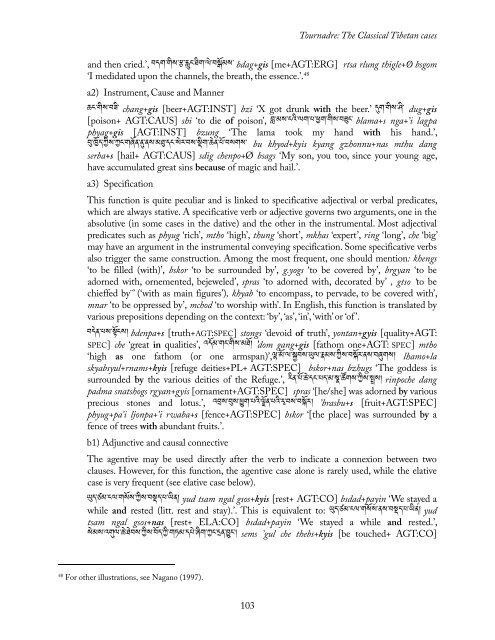The Classical Tibetan cases and their transcategoriality
The Classical Tibetan cases and their transcategoriality
The Classical Tibetan cases and their transcategoriality
Create successful ePaper yourself
Turn your PDF publications into a flip-book with our unique Google optimized e-Paper software.
103<br />
Tournadre: <strong>The</strong> <strong>Classical</strong> <strong>Tibetan</strong> <strong>cases</strong><br />
<strong>and</strong> then cried.’, བདག་གིས་རྩ་རླུང་ཐིག་ལེ་བསྒོམས་ bdag+gis [me+AGT:ERG] rtsa rlung thigle+Ø bsgom<br />
‘I medidated upon the channels, the breath, the essence.’. 48<br />
a2) Instrument, Cause <strong>and</strong> Manner<br />
ཆང་གིས་བཟི་ chang+gis [beer+AGT:INST] bzi ‘X got drunk with the beer.’ དུག་གིས་ཤི་ dug+gis<br />
[poison+ AGT:CAUS] shi ‘to die of poison’, བླ་མས་ངའི་ལག་པ་ཕྱག་གིས་བཟུང་ blama+s nga+’i lagpa<br />
phyag+gis [AGT:INST] bzung ‘<strong>The</strong> lama took my h<strong>and</strong> with his h<strong>and</strong>.’,<br />
བུ་ཁྱོད་ཀྱིས་ཀྱང་གཞོན་ནུ་ནས་མཐུ་དང་སེར་བས་སྡིག་ཆེན་པོ་བསགས་ bu khyod+kyis kyang gzhonnu+nas mthu dang<br />
serba+s [hail+ AGT:CAUS] sdig chenpo+Ø bsags ‘My son, you too, since your young age,<br />
have accumulated great sins because of magic <strong>and</strong> hail.’.<br />
a3) Specification<br />
This function is quite peculiar <strong>and</strong> is linked to specificative adjectival or verbal predicates,<br />
which are always stative. A specificative verb or adjective governs two arguments, one in the<br />
absolutive (in some <strong>cases</strong> in the dative) <strong>and</strong> the other in the instrumental. Most adjectival<br />
predicates such as phyug ‘rich’, mtho ‘high’, thung ‘short’, mkhas ‘expert’, ring ‘long’, che ‘big’<br />
may have an argument in the instrumental conveying specification. Some specificative verbs<br />
also trigger the same construction. Among the most frequent, one should mention: khengs<br />
‘to be filled (with)’, bskor ‘to be surrounded by’, g.yogs ‘to be covered by’, brgyan ‘to be<br />
adorned with, ornemented, bejeweled’, spras ‘to adorned with, decorated by’ , gtso ‘to be<br />
chieffed by¨’ (‘with as main figures’), khyab ‘to encompass, to pervade, to be covered with’,<br />
mnar ‘to be oppressed by’, mchod ‘to worship with’. In English, this function is translated by<br />
various prepositions depending on the context: ‘by’, ‘as’, ‘in’, ‘with’ or ‘of ’.<br />
བདེན་པས་སྟོངས། bdenpa+s [truth+AGT:SPEC] stongs ‘devoid of truth’, yontan+gyis [quality+AGT:<br />
SPEC] che ‘great in qualities’, འདོམ་གང་གིས་མཐོ། ་’dom gang+gis [fathom one+AGT: SPEC] mtho<br />
‘high as one fathom (or one armspan)’,ལྷ་མོ་ལ་སྐྱབས་ཡུལ་རྣམས་ཀྱིས་བསྐོར་ནས་བཞུགས། lhamo+la<br />
skyabsyul+rnams+kyis [refuge deities+PL+ AGT:SPEC] bskor+nas bzhugs ‘<strong>The</strong> goddess is<br />
surrounded by the various deities of the Refuge.’, རིན་པོ་ཆེ་དང་པད་མ་སྣ་ཚོགས་ཀྱིས་སྤྲས། rinpoche dang<br />
padma snatshogs rgyan+gyis [ornament+AGT:SPEC] spras ‘[he/she] was adorned by various<br />
precious stones <strong>and</strong> lotus.’, འབྲས་བུས་ཕྱུག་པའི་ལྗོན་པའི་རྭ་བས་བསྐོར། ’brasbu+s [fruit+AGT:SPEC]<br />
phyug+pa’i ljonpa+’i rwaba+s [fence+AGT:SPEC] bskor ‘[the place] was surrounded by a<br />
fence of trees with abundant fruits.’.<br />
b1) Adjunctive <strong>and</strong> causal connective<br />
<strong>The</strong> agentive may be used directly after the verb to indicate a connexion between two<br />
clauses. However, for this function, the agentive case alone is rarely used, while the elative<br />
case is very frequent (see elative case below).<br />
ཡུད་ཙམ་ངལ་གསོས་ཀྱིས་བསྡད་པ་ཡིན། yud tsam ngal gsos+kyis [rest+ AGT:CO] bsdad+payin ‘We stayed a<br />
while <strong>and</strong> rested (litt. rest <strong>and</strong> stay).’. This is equivalent to: ཡུད་ཙམ་ངལ་གསོས་ནས་བསྡད་པ་ཡིན། yud<br />
tsam ngal gsos+nas [rest+ ELA:CO] bsdad+payin ‘We stayed a while <strong>and</strong> rested.’,<br />
སེམས་འགུལ་ཆེ་ཐེབས་ཀྱིས་བོད་ཀྱི་གཏམ་དཔེ་ཞིག་ཀྱང་དྲན་བྱུང༌། sems ’gul che thebs+kyis [be touched+ AGT:CO]<br />
48 For other illustrations, see Nagano (1997).
















